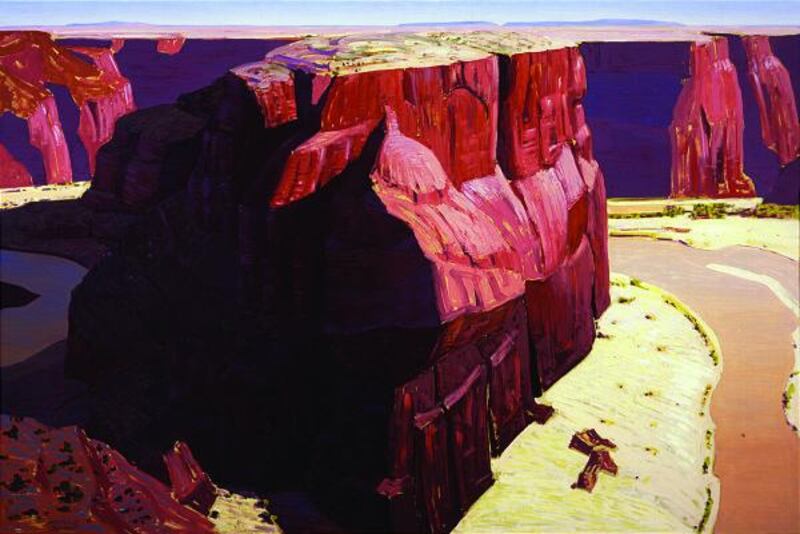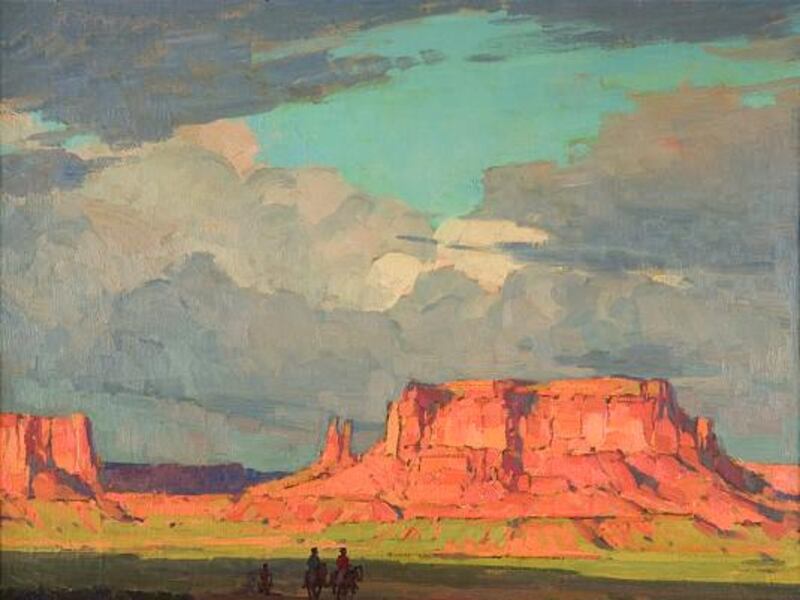In all the Earth, there is nothing quite like Utah's red rock country. The combination of color, landforms and climate create a mesmerizing landscape that has both intimidated and inspired filmmakers, poets and artists for more than a century-and-a-half.
Evidence of that is shown in an exhibition at the Utah Museum of Fine Arts — "The Continuing Allure: Painters of Utah's Red Rock," which runs through June 27.
The works, from private regional collections and the UMFA's permanent collection, span roughly a century and were created by both regional and national artists, such as William R. Leigh, Sven Birger Sandzen, Gary E. Smith, Edgar Payne, Maynard Dixon, Harold "Buck" Weaver and Conrad Buff.
In connection with the exhibition, a special lecture will be held Wednesday in which James D'Arc, film historian and conservator at BYU, will explore the topic: "When the Movies Raised Kane in Kane County: Hollywood Moviemaking in Utah."
The paintings offer breathtaking views of some of the West's most iconic sites, says Donna Poulton, curator of the show. While most of the works are representational in style, "each artist strove to create, in his own way, an authentic American experience, capturing and interpreting the challenging terrain."
What you will notice right off, however, she says, is that every painting is different. "There is not one style that grew out of the sense of place in southern Utah. That's very different from what happened in such places as Taos, with the California impressionists who lived there, or in the Hudson River Valley, or even with the French Impressionists."
It's not really hard to figure out why. "It was not a hospitable place to live, especially in the 1920s, when many of these artists were first working there. The roads were bad, there was no air-conditioning. They would have to come and camp out for a time and go home," Poulton says.
When William R. Leigh came to paint Rainbow Bridge in 1922, "he had to ride by horseback for five days over steep, slick rock to get there," she says.
Some of the paintings are "one-time-wonders," Poulton adds, representing the only time an artist came to Utah. That's what happened with Maurice Freedman. On a trip through southern Utah in 1967, the New York artist stopped at Bryce Canyon and painted what he described as "Indian Castles — sentinels overseeing, guarding and protecting their land and people." He never came back.
But some artists truly fell in love with the area and returned time after time. Conrad Buff, one of the "most-collected artists at the moment," Poulton says, was one of them. He was born and raised in Switzerland but moved to California in his mid-20s. After his first trip to Zion National Park in 1923, he returned to Utah frequently.
"During World War II, he came to Utah to 'hide out' because of his German accent," she says. "He did thousands of paintings, but the problem is that he never dated them or named the place he painted." While some are recognizable, others are more general.
Maynard Dixon saw one of Buff's paintings and decided he must come to the area. The painting in this show is from his first trip, when he came in 1933 with his wife, Dorothea Lange, and painted more than 43 canvases that summer and fall.
Charles Muench "tried and tried to paint Bryce" and felt he could never quite do it full justice, she says, yet his painting is gorgeous.
Other than the varied styles, what you will also notice about these works is that this landscape meant "the artists had to change the way they thought about painting," Poulton says. The lush, grand scale created its own rules.
For instance, "in landscape painting, the horizon line should be at the one-third or two-thirds point of the painting. Here it is often at one/twelfth. Also, the land generally should never be lighter than the sky, but here the sandstone often is." In the desert, they had to change the rules to get the weight, the heaviness of the rock, she says.
"And the artists love to use red and green together. Those are complimentary colors, but you can't use them together in many landscapes except in the desert."
Most of the paintings convey a sense of the largeness and vastness of the area, "but not everyone goes and feels the same thing," Poulton says.
The same is true of filmmakers, D'Arc notes. We think of films made in Kanab and think of the Western movie. While many were, many were not. That's what he doesn't think most people realize. "There was so much diversity, a wide representation of variety."
Many sites in southern Utah were used by Hollywood, and D'Arc is currently writing a book about filmmaking in the state. But this lecture will focus on Kanab, he says, because it was the most prolific area. Starting in 1924 with Tom Mix's "Deadwood Coach," and running until 1978's "The Apple Dumpling Gang Rides Again," there was an almost continuous stream of movies made in Kane County. A few have even been made there more recently.
He will show clips from a variety of films produced in the area, including John Ford's 1939 "Drums Along the Mohawk," Clint Eastwood's 1975 "The Outlaw Josey Wales," "The Greatest Story Every Told" (1965), "Galaxy Quest" (1999), "Broken Arrow" (1996), "The Lone Ranger" (1956), "Planet of the Apes" (1968), "Buffalo Bill" (1944) and "Western Union" (1941).
What's so fun about the backdrop of the movies, he says, is that it is ever-changing. "As opposed to still art, you get movement somewhat akin to real life. And you see how it has changed. The Angel Canyon where Best Friends now has an animal sanctuary is very different from the Angel Canyon you see in films. So you get to re-imagine the area. These movies serve a historical function, showing life before roads, before civilization. You see how the watershed has changed; you see a chronicle of the landscape of 20th century Utah."
What Poulton likes so much about the "Continuing Allure" exhibition is that you have to come to terms with a "universe so huge. There's no choice but to consider the bigger picture. So many artists came because of that. We only show a handful here. But they all give you a new way of looking at the world."
What: The Continuing Allure: Painters of Utah's Red Rock
Where: Utah Museum of Fine Arts, 410 Campus Center Drive, University of Utah
When: Through June 27, Tuesday-Friday, 10 a.m.-5 p.m., to 8 p.m. on Wednesdays; weekends, 11 a.m.-5 p.m.; closed Mondays and holidays
Admission: $7, adults; $5, seniors and youth 6-18; free, U. of U. students and staff, children younger than 6
Also: "When Movies Raised Kane in Kane County," presented by James D'Arc
Where: UMFA
When: Wednesday, March 31, 7 p.m.
Admission: Free
e-mail: carma@desnews.com




